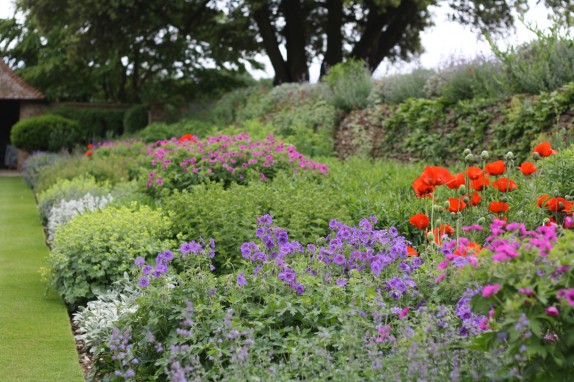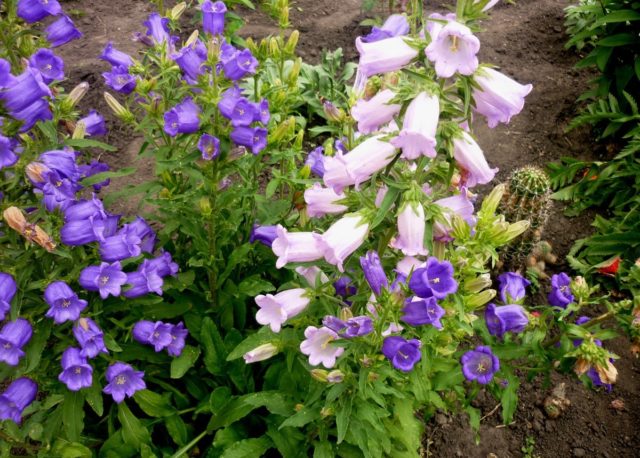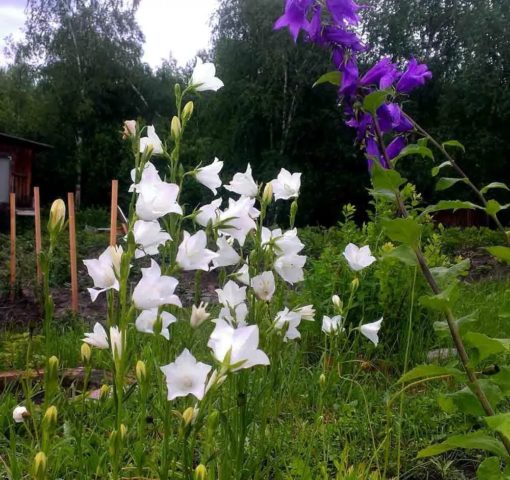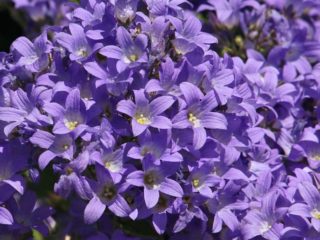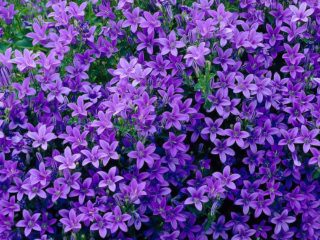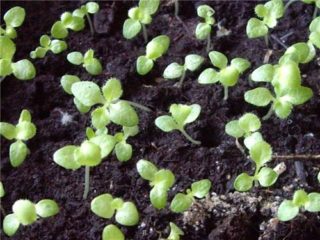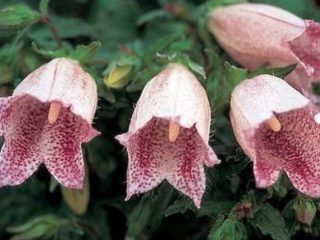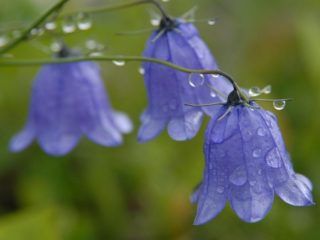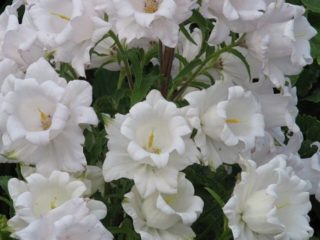Content
Campanula latifolia (Campanula latifolia) is a tall perennial plant that gets its species name from the shape of its flowers. The genus includes more than 300 species, differing in territorial distribution, color and height. In ornamental gardening, varietal representatives are used that are created specifically for landscape design.
Description of the broadleaf bell
The main types of broadleaf bellflower grow in the form of a herbaceous shrub consisting of 4-6 shoots. The crop is tall, the stems reach 100-150 cm. The bush is compact, intensively leafy. The plant is adapted to all types of soil, but full vegetation is possible only on fertile, light soil with moderate moisture.
The frost resistance of the plant depends on its distribution area. Species of northern latitudes withstand temperatures dropping to -300 C, representatives of the Caucasus or Asia Minor are not adapted to the winter conditions of the Central regions and the Middle Zone. In ornamental gardening, breeding varieties based on Altai or Himalayan varieties are used, which can easily withstand weather conditions of a temperate climate.
The culture is sun-loving, flowers do not fade in direct sunlight. The plant calmly reacts to lack of moisture. Damp soils and high air humidity do not meet the biological requirements of the broadleaf bellflower; in such conditions, the plant gets sick, grows poorly, and forms a small number of buds.
The life cycle of flowers decreases, they lose their shape, close and droop. The splendor of flowering directly depends on the sufficiency of lighting, soil fertility and compliance with agricultural practices.
What does broadleaf bluebell look like?
The broadleaf bell attracts attention with its lush green mass and long flowering (from June to July). The main color of the flowers of this species is blue, violet or dark blue. Flowering is abundant, the buds open sequentially.
External characteristics of the broadleaf bell:
- Stems are erect, without lateral branches, light green. The surface is smooth, the shape is round, the top is thin and angular.
- The leaves are located along the entire length of the stem, oblong, wide at the base, pointed at the top, serrated edges. Near the root, the larger ones are attached to winged petioles, the upper ones are smaller, sessile.
- The leaf blade is light green with pronounced veins, densely pubescent in the lower and upper parts.
- The inflorescence of the broadleaf bell is racemose, formed from the middle of the stem.The flowers are large (up to 3 cm in length), located in the leaf axils on short stalks. The shape is funnel-shaped, bell-shaped, the edges are dissected and curved.
- The fruit is a capsule with flat brown seeds.
Broad-leaved bellflower is recommended for cultivation in the European part, the Central region, the regions of the Middle Zone, and the northern Caucasus.
The perennial crop, after sowing the seeds, reaches reproductive age in the third year of the growing season.
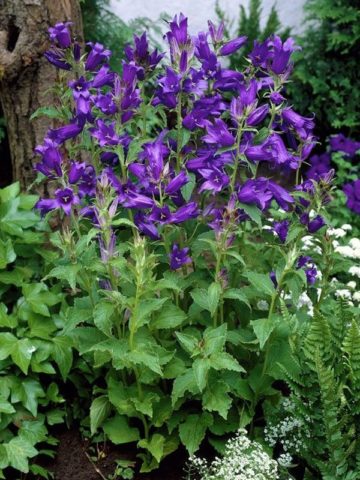
The bell bush does not grow quickly or strongly, occupying no more than 50 cm² of area
What is the root system of broadleaf bellflower?
The root system of the broadleaf bell is of mixed type, the dominant stem is spindle-shaped. On fertile light soil, the central part deepens by 15-20 cm, lateral fibrous roots cover 60 cm of territory.
A plant with low stress resistance, does not respond well to transplantation, and is prone to trampling on pastures. If the climatic conditions of the region do not correspond to the species, the crop does not recover after the roots freeze.
Where does broadleaf bluebell grow?
Broadleaf bellflower grows on the edges of mixed and coniferous forests. More often found in meadows, hillsides, and foothills. If located near a forest, the root is slightly deepened within 6 cm and forms only one stem, so the main accumulation is in open areas in moderately moist soils.
Depending on the variety, the species' distribution range covers the European part, Altai, alpine meadows near the Caucasus Mountains, the Far East, Eastern Siberia, and part of the Urals.
Why is the broadleaf bell in the Red Book?
The culture is classified as an endangered species; the broad-leaved bell flower is listed in the Red Book and is protected by law. Every year the plant population decreases; a number of negative factors influence the extinction of the species:
- economic activity, increasing areas for grazing. The bell does not recover after mechanical damage to the vegetative buds;
- early haymaking. The plant does not have time to enter the fruiting phase;
- In the natural environment, the crop reproduces by self-seeding, the germination rate of the material is 15%. Young plants are practically never found in the wild. The established population reproduces as a result of branching and growth of the root system. In the meadows, the crop is trampled by cattle, which leads to its disappearance.
This factor also contributes to the disappearance of the broadleaf bell. Wild species enter reproductive age at 5-7 years; many of the specimens do not survive until this time. The crop is characterized by low competitiveness and does not respond well to soil compaction, so it is replaced by more adapted plants with a creeping root system.
The best varieties
There are quite a few varieties of broadleaf bellflower in nature. There are few breeding varieties with high frost resistance and low watering requirements. Cultivars are used in ornamental gardening and only 3 varieties can be classified as in demand.
Bruntwood

Bluebell broadleaf Bruntwood reaches a height of 1.2 m
The bush is dense, formed by 6-10 stems.The inflorescences are lush, the flowers are dark blue with a slight purple tint. Suitable for cultivation in all regions (except the Far North).
The flowering period of the Bruntwood variety occurs at the end of June and lasts until the first days of August.
Alba
A rare white form of the broadleaf bellflower Alba is one of the common varieties in design. The plant owes its popularity to its unconventional flower color and high frost resistance. This is a herbaceous compact shrub, the height of which is about 80 cm. The shape of the flowers is bell-shaped, dissected, sharp corners, the upper part looks like a star. To plant plants of this variety, choose an area with periodic shading.

The flowering period of the Alba variety begins in the first ten days of June and continues until mid-August
Makranta
The variety of broad-leaved bell Makrantha (Macrantha) compares favorably with other breeding varieties in the size of the flower and the density of the inflorescences.

The color of the flowers of the Macrantha variety is dark purple, the cup is completely open, with clearly defined petals
Flowering period – June-July.
Application in design
Garden forms of the broadleaf bell are used to create:
- mixborders;
- compositional structures in the flowerbed;
- for decoration in the style of wild nature;
A tall bell can serve as a background plant for low-growing shrubs and dwarf forms of conifers.
Combine bellflower with crops of the same size, with white, pink or yellow flowers. All species located nearby should have similar placement requirements.
Do not combine broadleaf bellflower with ornamental plants that bloom with blue inflorescences.Neighborhood with aggressive species that have a creeping root system is undesirable.
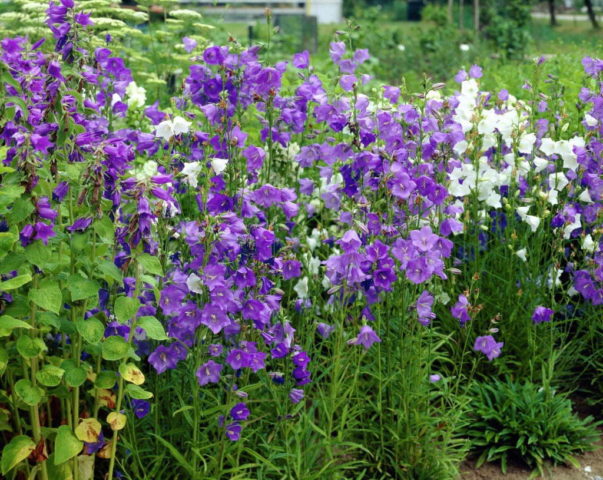
Mass planting based on varieties with different colors is often used to decorate empty areas of the site
How does broadleaf bellflower reproduce?
Bellflowers are propagated in a generative way. In the fall, they collect seeds, make a bed, and sow them in the ground in October. For the winter, the area is covered with film and insulated with spruce branches on top. In the spring, the seeds will germinate, they are picked and planted in the designated area in the fall. Garden varieties are divided once every 5 years to obtain additional planting material.
Landing algorithm
The area for planting broadleaf bells is sunny or with periodic shading.
In constant shade and high humidity, the bell will not grow, so there is a risk of death of the crop. The soil is selected in a dry area to avoid stagnation of moisture. The soil should be neutral or slightly alkaline, always light and fertile.
The bush is divided in May or at the end of August (after flowering). After sowing, seedlings are planted for the winter at the same time.
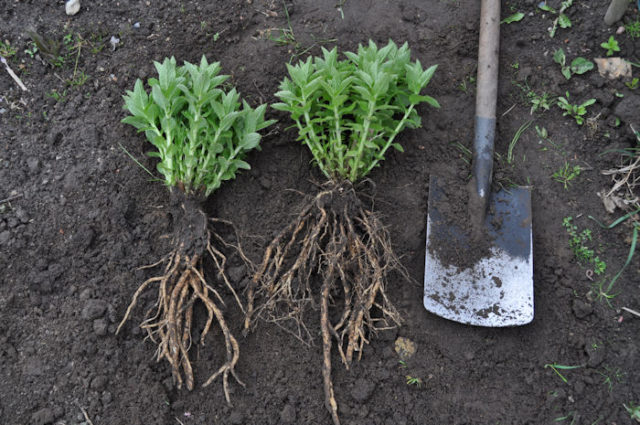
The bell is dug up and the root is divided so that each section consists of a central rod and several lateral root threads
5 days before planting, the seedlings are watered with a weak solution of manganese, and before being placed in the ground they are treated with a growth-stimulating drug. The site is prepared on the day of planting, it is dug up along with compost, and poured with boiling water.
Algorithm for carrying out planting work:
- The hole is made 40 cm deep, 30 cm wide (for seedlings) and 10 cm wider than the root - when dividing the bush.
- Mix peat, turf soil and sand, add superphosphate and potassium.
- The bottom of the recess is covered with a layer of drainage and covered with part of the substrate.
- The bell is placed in the center and the hole is filled with the remaining soil mixture.
The soil is compacted, the plot is watered with water with the addition of nitrogen fertilizer. For seedlings, this measure is not necessary. The top is covered with mulch; the bell does not tolerate even slight compaction of the top layer of soil.
Aftercare
Agricultural technology consists of carrying out the following activities:
- During the dry season, water the plant 2 times a week in the evening. If precipitation is normal, additional watering is not required.
- The varieties are tall; if the bush does not hold its shape well, the bell is tied up.
- Mulch immediately after planting with peat, sawdust or wood chips.
- Loosen the soil at the first signs of compaction.
- Fertilizing begins in the second year of the growing season. The first procedure is carried out in the last ten days of May with nitrophoska; during flowering, “Agricola for flowering plants” is added; when the flowering cycle is over, it is fed with superphosphate and potassium.
Preparing for winter
By autumn, the above-ground mass dies and dries out; it is cut off completely. Loosen the soil around the bush, lightly hill it up, sprinkle it with ash to deoxidize the soil, spread compost and cover it with a layer of mulch. If the winter is cold and there is little snow, they are covered with spruce branches.
Diseases and pests
The following diseases have been noted on broadleaf bellflower:
- rot of the root collar and roots;
- powdery mildew;
- rust.
In the fall, after flowering, the plant is treated with copper sulfate, and in the spring with Topaz.
They parasitize the plant:
- aphid;
- slobber;
- slugs
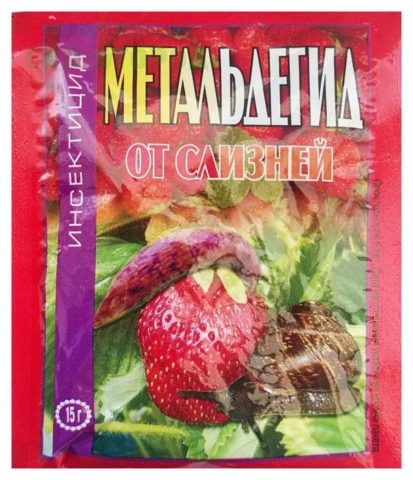
To get rid of pests, flowers are sprayed with Iskra, and Metaldehyde is placed near the bush.
Conclusion
Campanula latifolia is a field perennial plant with a mixed type of root system. It grows in dense groups and has the shape of a herbaceous bush. The bell is considered an endangered species, so the culture is protected by law. The design uses garden forms with purple and white flowers. Selected varieties are frost-resistant, so they can be grown in any climate zone.

